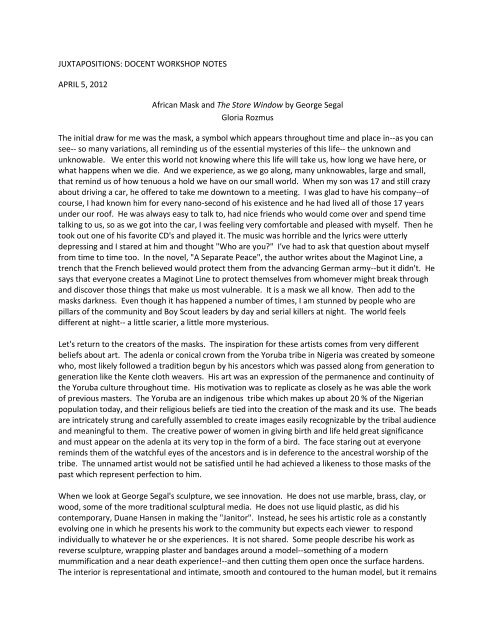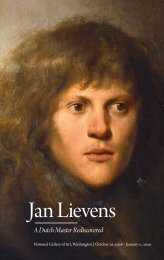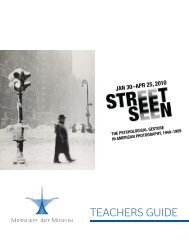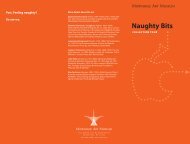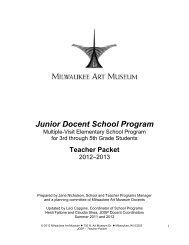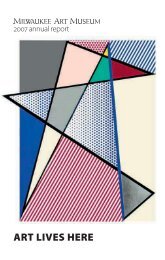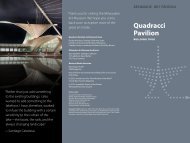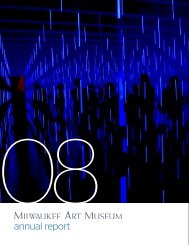Juxtapositions-Notes - Milwaukee Art Museum
Juxtapositions-Notes - Milwaukee Art Museum
Juxtapositions-Notes - Milwaukee Art Museum
Create successful ePaper yourself
Turn your PDF publications into a flip-book with our unique Google optimized e-Paper software.
JUXTAPOSITIONS: DOCENT WORKSHOP NOTES<br />
APRIL 5, 2012<br />
African Mask and The Store Window by George Segal<br />
Gloria Rozmus<br />
The initial draw for me was the mask, a symbol which appears throughout time and place in--as you can<br />
see-- so many variations, all reminding us of the essential mysteries of this life-- the unknown and<br />
unknowable. We enter this world not knowing where this life will take us, how long we have here, or<br />
what happens when we die. And we experience, as we go along, many unknowables, large and small,<br />
that remind us of how tenuous a hold we have on our small world. When my son was 17 and still crazy<br />
about driving a car, he offered to take me downtown to a meeting. I was glad to have his company--of<br />
course, I had known him for every nano-second of his existence and he had lived all of those 17 years<br />
under our roof. He was always easy to talk to, had nice friends who would come over and spend time<br />
talking to us, so as we got into the car, I was feeling very comfortable and pleased with myself. Then he<br />
took out one of his favorite CD's and played it. The music was horrible and the lyrics were utterly<br />
depressing and I stared at him and thought "Who are you" I've had to ask that question about myself<br />
from time to time too. In the novel, "A Separate Peace", the author writes about the Maginot Line, a<br />
trench that the French believed would protect them from the advancing German army--but it didn't. He<br />
says that everyone creates a Maginot Line to protect themselves from whomever might break through<br />
and discover those things that make us most vulnerable. It is a mask we all know. Then add to the<br />
masks darkness. Even though it has happened a number of times, I am stunned by people who are<br />
pillars of the community and Boy Scout leaders by day and serial killers at night. The world feels<br />
different at night-- a little scarier, a little more mysterious.<br />
Let's return to the creators of the masks. The inspiration for these artists comes from very different<br />
beliefs about art. The adenla or conical crown from the Yoruba tribe in Nigeria was created by someone<br />
who, most likely followed a tradition begun by his ancestors which was passed along from generation to<br />
generation like the Kente cloth weavers. His art was an expression of the permanence and continuity of<br />
the Yoruba culture throughout time. His motivation was to replicate as closely as he was able the work<br />
of previous masters. The Yoruba are an indigenous tribe which makes up about 20 % of the Nigerian<br />
population today, and their religious beliefs are tied into the creation of the mask and its use. The beads<br />
are intricately strung and carefully assembled to create images easily recognizable by the tribal audience<br />
and meaningful to them. The creative power of women in giving birth and life held great significance<br />
and must appear on the adenla at its very top in the form of a bird. The face staring out at everyone<br />
reminds them of the watchful eyes of the ancestors and is in deference to the ancestral worship of the<br />
tribe. The unnamed artist would not be satisfied until he had achieved a likeness to those masks of the<br />
past which represent perfection to him.<br />
When we look at George Segal's sculpture, we see innovation. He does not use marble, brass, clay, or<br />
wood, some of the more traditional sculptural media. He does not use liquid plastic, as did his<br />
contemporary, Duane Hansen in making the "Janitor". Instead, he sees his artistic role as a constantly<br />
evolving one in which he presents his work to the community but expects each viewer to respond<br />
individually to whatever he or she experiences. It is not shared. Some people describe his work as<br />
reverse sculpture, wrapping plaster and bandages around a model--something of a modern<br />
mummification and a near death experience!--and then cutting them open once the surface hardens.<br />
The interior is representational and intimate, smooth and contoured to the human model, but it remains
inside and unseen, a full body mask. Structural buildings are also a part of his innovation, and the "Store<br />
Front" tells us that it is night since the display window is empty, closed off from the store, and the<br />
darkened doorway where the woman stands surrounds her protectively so that you can't approach her<br />
from the back or sides but only directly from the front.<br />
That brings us to the gaze. Haven't you ever thought of ripping off that plaster to find out who belongs<br />
to those piercing cold eyes that stare directly at you from the "Store Front" The eyes are the first thing<br />
people notice and the first thing they want to talk about when they see her. They are almost like<br />
weapons that make people want to back away. While the Yoruba tribe gathers around a night time fire<br />
awaiting a ritual ceremony, the world of the "Store Front" and its urban tribal community have much<br />
scarier rituals, and I'm sure all of the women here keenly understand the danger of standing alone in a<br />
darkened doorway. The gaze is small protection.<br />
On the other hand, it is said that the Nigerian mask or adenla originally had more strands of beads that<br />
hung over the face in order to protect the tribal audience from the powerful gaze of the ruler. Not only<br />
did he wear the supernatural powers of women and the watchful face of his royal ancestors but he may<br />
also have had some mind-enhancing drugs in this mask! Imagine how invincible that would make him<br />
feel as he came before his people. His mask was not for the purpose of hiding his identity but for<br />
establishing a heightened identity, adding powers no other human could have. This strong, muscular<br />
warrior king faces his tribe as they wait in the darkness lit by a crackling fire. Perhaps there are<br />
drumbeats, chants, dance accompanying the ceremony, and everyone understands and recognizes the<br />
meaning and purpose of this event. They are unified in their homage to the warrior king.<br />
"The Store Front" always reminds me of the mother of a high school friend of mine. My friend's name is<br />
Gloria too and we are only a day apart in age, but that is where similarities end. I always remember her<br />
mother at the door when I'd stop there after school. She wore a house dress, an apron, and sturdy<br />
sensible shoes, and she had thinning mousy brown hair but a very placid face. Gloria told me that her<br />
parents never argued or raised their voices, so I thought they were a perfect family and that she lived on<br />
the set of "Father Knows Best" or something. Her mom didn't drive, and when we turned 16, she sat<br />
down with her daughter and said to her "I have spent my whole life waiting". Waiting for her husband<br />
to come home so that she could serve dinner, waiting until he could find time to take her to the store or<br />
run errands, occasionally finding friends who offered to take her places or waiting for a bus. She was<br />
always on someone else's schedule. when I heard that, I thought that I had been given the chance to<br />
peer behind her mask for a moment . When I see the folded arms of this woman, it is almost a snapshot<br />
of a time frozen in the 50's and 60's when the passive role of so many mothers I met was the norm. And<br />
then along came the third Gloria, Gloria Steinem, and feminism started to make war with that norm. Of<br />
course, it was too late and too radical for Gloria's mom to consider turning her comfortable and<br />
unobtrusive world upside down. But the "Store Front" captures something of that era.<br />
Although these two selections have in common a mask, a solitary figure set in darkness, and a powerful<br />
gaze, the differences are profound: male vs. female<br />
powerful vs. vulnerable<br />
active vs. static<br />
tribal vs. urban<br />
community vs. disunity<br />
tradition vs. innovation<br />
And the list goes on. For me, the wildly different expressions of this powerful symbol, the mask, drew<br />
me in.
Barbara Hepworth Sculptures Juxtaposed with Lake Michigan<br />
Robert Mitchell<br />
The positioning of the three Barbara Hepworth sculptures, “Single Form: Ikon, (or Eikon)”, “Single Form:<br />
Antiphon,” and “Two Piece Marble: Rangatira,” reinforces Hepworth’s aesthetic. With some<br />
imagination (more like a willing suspension of disbelief) the alcove that faces east over Lake Michigan is<br />
like Trewyn Studios in St. Ives, Cornwall, England, where Barbara Hepworth spent the last 35 years of<br />
her life enjoying the moods of the Atlantic Ocean, facing east. In a 1966 interview, Hepworth recounted<br />
that “ . . . what was lacking in Yorkshire [her birthplace] I only discovered when I went to Italy, and that<br />
was light. In my work I’ve always used light a great deal. I test everything I do by sunlight, and by<br />
moonlight, and in rain and greyness.”<br />
I wrote to Dr. Sophie Bowness of the Hepworth Estate about the titles of Hepworth pieces. (Dr. Bowness<br />
is a granddaughter of Barbara Hepworth.) She replied via her assistant, stating that Hepworth started<br />
using Greek titles and subtitles in the mid-1940s, although she didn’t travel to Greece until the summer<br />
of 1954. Icon, meaning image, appears repeatedly as a title or subtitle. The shape of our piece dates<br />
back to the 1937 plaster “Single Form,” and the subtitle was added when the bronze was cast in 1963.<br />
Hepworth professed a Romantic attitude of emotional affinity with nature. She spoke of the vitality of<br />
the material, “essential stone shapes and essential wood shapes which are impossible for me to<br />
disregard.” Note, for example, how the five planes of the surface of “Ikon” subtly merge, while the<br />
upright form with its rich patina is reminiscent of the irresistible green shoot. However, the top plane is<br />
a “cut-off” which not only provides interest but distances the form from a representational figure.<br />
(Hepworth referred to her pieces of sculpture as “forms,” not “figures.”)<br />
“Antiphon”(originally a 1953 boxwood carving, bronze casting 1969) recalls a sung response to an<br />
invocation in a liturgy, and thus advances the notion of a relationship between the “Single Form” and<br />
another entity. It is pierced in two different orientations, thus reinforcing the notion of conversation.<br />
The holes are angled so as to draw the viewer’s gaze in and out. Hepworth: “I felt the most intense<br />
pleasures in piercing the stone in order to make an abstract form and space; quite a different sensation<br />
from doing it for the purpose of realism.”<br />
In regard to “Two Piece Marble,” Dr. Bowness says, “Rangatira is a Maori word for a chief or person of<br />
noble birth. Barbara Hepworth owned two Maori dictionaries given to her by a New Zealand friend. . . .<br />
She also used it for two screenprints—“Rangatira I and Rangatira II, from the series Opposing Forms,<br />
1970.” The form does remind me of a stout Maori chief looking out over his domain. In any event, we<br />
can peer through the holes to our inland sea.<br />
The biographical details of Dame Barbara Hepworth’s life are widely available from an internet search.<br />
A good site is www.tate.org.uk/stives/hepworth/ which includes views of her sculpture garden. Video<br />
clips of Hepworth talking about her work are worth watching.
Suzie Hanks<br />
Marino Marini, Italian 1901 – 1980, Horse with Head Looking Up, 1956, Bronze<br />
Marino Marini, Italian 1901 – 1980, Battle, 1952, Oil on Canvas<br />
Etruscan (Faliscan), Oinochoe (pitcher) 325B.C., Red figure Terracotta<br />
Greek Attic, Horse Pyxis (circular box), ca. 760 – 735 B.C., Terracotta<br />
Marino Marini<br />
Marini is considered one of the great artists of the 20 th century by virtue of his sculpture and is ranked<br />
with Moore, Lipchitz, Calder and Picasso. He was born in Pistoia, Tuscany in 1901 and was very strongly<br />
influenced by the art of the ancient Etruscans who’s culture flourished in that part if Italy from<br />
approximately 700 -250B.C. At the beginning of his career, he rented a studio at a riding school. During<br />
WWII, his apartment and studio in Milan were destroyed in an air raid. His work was introduced to the<br />
U.S. in 1950 by Curt Valentin and has always been widely exhibited in Europe. He won many prizes and<br />
honors during his life and there are now three museums in Italy: Pistoia, Milan and Florence entirely<br />
devoted to his work. His themes are limited to four subjects, the horse and rider, Pomona and the<br />
juggler. After WWII, his work became more abstract, reflecting the trauma he experienced during the<br />
war and expressing his anxiety for the future of mankind. Marini’s work shows the Etruscan influence by<br />
also having a delicate sense of humor which is often subtle and disguised. He uses bright color to<br />
express emotion. His forms have an archaic simplicity of shape. His works have nobility; are rhythmic<br />
and dynamic. The horse symbolizes man’s animal nature, his virile creative capacity. But the rider has<br />
lost his connection to the horse – is reeling and will fall.<br />
Marini speaks for himself:<br />
“You consider one of my equestrian statues of these past twelve years. You will notice each time the<br />
horseman is incapable of managing his mount and that the animal in its restlessness ever more riderless<br />
comes more and more to a rigid standstill instead of rearing. I believe in the most serious way that we<br />
are headed toward the end of the world.”<br />
Etruscan Oinochoe 325 B.C.<br />
Here is an example of Etruscan art - a wine pitcher reflecting man’s animal nature as seen in the horse<br />
and man’s loss control over it. This comes from the culture that had such an enormous influence on<br />
Marino Marini.<br />
“I see myself as a descendant of the Etruscans … what interests me is the primitive, the elemental. The<br />
Etruscans move me so profoundly just because their nature is absolutely original. A nature that …<br />
contains so much of the warmth of life that it can live on its own accord developing continually down<br />
the centuries. This is why I have always sought roots of human endeavor such as these.”<br />
Who were the Etruscans They lived in western Italy in self-governing cities from about 700B.C. –<br />
250B.C. All that we know of them come from their tombs, which were filled with frescoes, pottery,
onze statuettes, sarcophagi, cinerary urns and canopic jars. Their tomb entrances are often marked<br />
with a phallic pillar said to symbolize the regenerative nature of life, death and rebirth. Although, one<br />
must keep in mind that this was said by D. H. Lawrence, one of their most romantic chroniclers. Ever<br />
since they were conquered by the Roman’s in the 2 nd century B.C., men have been writing about them<br />
and collecting their antiquities. But we are no closer to knowing where they came from or who they<br />
really were. D.H. Lawrence wrote a series of travelogues about Etruria and his visits to their tombs in the<br />
late 1920s. He seems to have the same sensibility and emotional response to them as Marino Marini.<br />
Consequently, he is a wonderful source in spite of his romantic hyperbole.<br />
Greek Horse Pyxis 760 – 735 B.C.<br />
This is a cosmetic box from the archaic period (700 – 480B.C.). The horse is standing serenely on all four<br />
legs on the lid of the box. He has no foreknowledge of the subversion that will come to the geometric<br />
design beneath him around the belly of the box. The Etruscans also used this symbol on their terra<br />
cottas. The swastika is a universal symbol, at least 5,000 years old and in most cultures has had positive<br />
associations such as wellbeing, the power of the life force and cyclic regeneration. Now, sadly it will<br />
forever be associated with the terrible destruction of Nazi fascism which contributed to Marino Marini ‘s<br />
visions of the apocalypse.
THE CHAIR (outline), presentation for MAM Juxtaposition Workshop, April 5, 2012, by Irene Morgan<br />
Definition: chair , n 1) a piece of furniture consisting of a seat, three or four legs, a seat and a back, often<br />
with arms, sometimes with rockers at the end of the legs, designed to hold one person. 2) a seat of<br />
office, authority, dignity, power, prestige, honor, such as the Chair of the Senate Ways and Means<br />
Committee, a university department Chair, an endowed Chair (professorship), the first Chair of an<br />
orchestra section. As v, to install in a position of authority; to provide over: to chair a meeting.<br />
Forerunner of the chair is the stool. n, a simple seat with three or four legs and no back or<br />
arms, sometimes with no legs but supported on a central pedestal.<br />
Pieces to be considered in this presentation: The Asante/Ashanti Leopard Stool (Osebo Dwa); Portrait of<br />
William Adams, Frank Duvenek; Found Object – Rocking Chair<br />
Leopard Stool, (Osebo Dwa),early 20 th C., probably 1920s, carver unknown. 22x22x12 inches. Gift of<br />
African American <strong>Art</strong> Alliance, (M.2000.l65).<br />
Out of context. A single object of many that symbolize and honor an individual entity – that of the oba.<br />
It was never meant to be in a museum. The whole package that symbolizes the oba in addition to the<br />
stool, includes kente cloth, gold jewelry, ritual vessels of various kinds, the umbrella, the horse. Even<br />
one of these exudes power, wealth and status. Taken together, they are a powerhouse of prestige.<br />
The stool is a symbolic representation of the original Golden Stool of the santehene (Asante King) Oseitutu<br />
who unified the people in the 17C. POSSIBLY THE MOST POWERFUL OBJECT IN OUR ENTIRE<br />
COLLECTION, a potent symbol of a potent individual, imbued with power, status, strength, leadership, in<br />
addition to containing the very soul of the Asante people.<br />
Significance of leopard as symbol. The Asante revere and respect the leopard, noted for its strength,<br />
fierceness, power, and independence. As a symbol, it belonged to the oba, no one else was allowed to<br />
use it.<br />
Portrait of William Adams, 1874. Frank Duvenek. American, 1840-1919. Oil on canvas, 60 ¼” x 48 ¼”.<br />
Gift of Mr. and Mrs. Lyron Laskin, Mr. and Mrs. George G. Schneider and Dr. and Mrs. <strong>Art</strong>hur J. Patek,<br />
Jr., in Memory of Dr. and Mrs. <strong>Art</strong>hur J. Patek. M1965.30<br />
Here we have a man, sitting in what is described as “…a sort of Shaker chair…”. A painting that combines<br />
the attributes of such a chair with a psychologically penetrating portrait of the sitter – they belong to<br />
each other.<br />
A word about the Shakers, a monastic, religious, communal society called The United Society of<br />
Believers in Christ’s Second Appearance. Theirs is a powerful legacy. Their austere way of living<br />
reflected their austere religious belief. Shaker furniture design was inspired by their religious beliefs, as<br />
well - austere, simple, plain, durable, honest, up-right. No decoration of elaborate details. (“An object<br />
well-made is ‘an act of prayer’”)
Looking at the subject of Duvenek’s portrait, consider adjectives to describe him: austere, up-right,<br />
simply dressed, no decoration or elaborate detail., a man of integrity, no nonsense, straightforward.<br />
The sitter reflects the attributes of the chair.<br />
American Realist painter, Frank Duvenek, (b. Covington, KY 1848, d. Cincinnati ,1919) migrated across<br />
the Ohio River as a teen-ager to Cincinnati, with its strong German community. At 21, he went to<br />
Germany to study at the Munich Academy, noted for its dark, realistic style of direct painting,<br />
reminiscent of the work of Rembrandtr, Franz Hals and Rubens, with their dark backgrounds, light and<br />
dark contrasts, slashing brushstrokes and heavy paint application, which later influenced Robert Henri’s<br />
circle. Duvenek mastered the technique and developed a preference for picturesque characters as<br />
models , as he did in this portrait, which he painted in 1874 when he returned to Cincinnati. It was<br />
exhibited together with five Munich portraits at the Boston <strong>Art</strong>s Club in 1875, creating a sensation.<br />
Why Because it was a radical departure from the academic style the public was accustomed to from<br />
the then very poplar Hudson River School. The painting was so admired by aspiring artist Elizabeth<br />
Boott, she persuaded her father to buy it for her. She became Duvenek’s pupil and later his wife. They<br />
returned to Munich and lived in Italy and as well headed up a group called “Duvenek’s Boys” which<br />
included William Merrit Chase and John Thwachtman. Upon his wife’s early death, Devenek returned to<br />
Cincinnati in 1888 where he continued to paint and teach until his death in 1919 at the age of 70.<br />
Compare William Adams and The Grandfather. Whose lap would you prefer to climb up into For<br />
Touring – Portraiture, of course. Painting Techniques. American History Through <strong>Art</strong>. The arm chair at<br />
the head of the table for the host/father/distinquished guest. Historically, men were seared and served<br />
first, then the women, then the kids. In Colonial times, the kids would be eating standing. It was a rite<br />
of passage to be granted a place at the table. Many times tables for large groups were formed by<br />
putting boards on sawhorses – hence, the term “chairman of the board.”<br />
Found Object – Rocking Chair, c. 1950. Michael and Julie Hall Collection of American Folk <strong>Art</strong>. M1989,<br />
part gift, part purchse. Unidentified artist, W. WA. Welded and painted steel farm implements.<br />
Acquired near Cooper Union, NY, 1985<br />
MOST CREATIVE OF THE THREE PIECES PRESENTED – to take “throw- aways, junk, and put the pieces<br />
together imaginatively to create a useful object. Using objects relating to mid-20C farm, the metal seat<br />
comes from a riding machine, mowing sickle knives decorate the base, and a mule shoe fastens to a<br />
hinge on the front. Welded to the sides are shovels, a faucet handle, half a pair of tin snips, a fitting<br />
from a single-tree harness, a small pitch fork, a round cheek piece and half a pair of a snaffle horse bit, a<br />
pulley and hook, half a pair of scissors, a pig ringer, railroad spikes, and a handle for lifting wood burning<br />
stove lid. The chair’s runners are lease springs, and the front braces are railroad springs, and the front<br />
braces are railroad spikes. The back of the chair consists of fancifully bent wire rods, and an electrical<br />
conduit forms the body. Completing the decoration, chain link surrounds the back and seat. Two items<br />
which help to date this vernacular equivalent to “high modern” found art and assemblage are the<br />
WALSCO long shank bicycle lock welded to its side, and the slant front scale that serves as the seat’s<br />
balancing spring. WALSCO made locks until the second World War and the slant front scale was<br />
patented in October 29, 1912.


